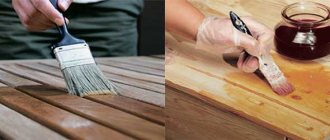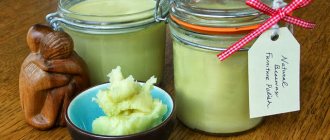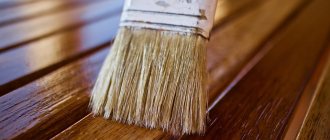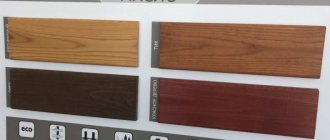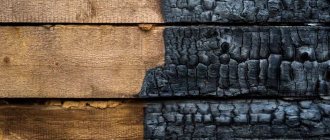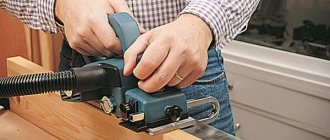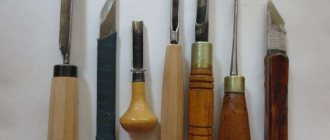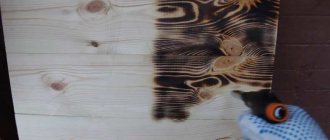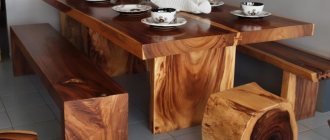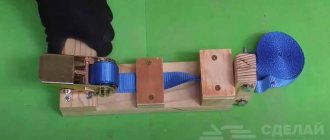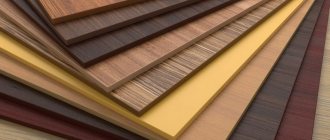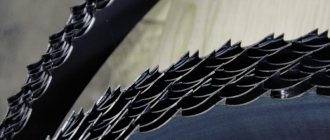A competent approach to choosing a protective agent is a guarantee of increasing the durability of raw materials, resistance to environmental influences, and improving its appearance.
Wood antiseptics are classified according to several parameters. To buy the drug in accordance with its purpose and functions, we recommend that you read this article: “Wood impregnations”.
Based on reviews from ordinary users and specialists, a rating of high-quality antiseptics from trusted manufacturers was compiled.
Pinotex Natural
There are a large number of good reviews from builders and woodworking specialists about Pinotex Natural antiseptic, made in Estonia. It is called the most transparent of all compositions for outdoor use. The natural beauty and color of the wood will be reliably protected for 3 years. It is applied to the surfaces of the walls of wooden structures using brushes or a spray gun. The average product consumption is 0.8-1.2 liters per square meter.
Binders make it possible to create a stable transparent film using an antiseptic. Among the disadvantages, users note slow drying.
Why does wood need antiseptic treatment?
What is antiseptic? This is the impregnation of wood with various chemicals that preserve it from the inside. But why should such a convenient building material be “preserved”? Now we will try to explain.
Interesting fact: wood is similar in structure to reinforced concrete structures. It also consists of “rebar” and “concrete” - two main compounds, cellulose and lignin. Cellulose is a polymer with a linear structure, but lignin has a developed multidimensional structure. Lignin, like concrete, has high compressive strength, while cellulose provides wood with flexibility.
That's why, when building a house out of wood, it is important to remember that you are working with living material, and all living materials obey the laws of nature. In the process of its development, a tree forms organic compounds from inorganic compounds, and after the end of its life, the tissues begin to be processed by saprophytes, popularly called fungi.
Fungi feed on dead wood fibers and convert them back into minerals. At the same time, mushrooms secrete special enzymes and grow mycelium using spores, which requires a certain temperature, oxygen, nutrients and water.
Moreover, these fungi are divided into two main groups - wood-coloring and wood-destroying .
The former develop only on wood of natural moisture and along the way give it a shade of blue, red, yellow or green, remaining mainly in the sapwood and only occasionally penetrating into the core. They die when heated above 80°C, and during their lifetime they do not have a significant effect on the strength of wood, because they are unable to destroy lignin. Therefore, the very presence of an unattractive shade of wood is rather a sign of a violation of the transportation and storage of lumber.
But the presence of wood-staining fungi in wood often indicates the risk that the same material is also infected with wood destroyers of the same kind. Also remember that wood-staining mushrooms often mask rot with their color. But wood-destroying fungi are capable of destroying wood completely, transforming it into dust and humus, and this is a natural process, as you remember.
That is why, even during the production of building material for the home, it is subjected to conditions unfavorable for the development of fungi: harsh drying, high temperature, and the use of carefully selected chemicals.
Here we are talking about antiseptics:
Tikkurila Valtti Expert Base
Paint and varnish impregnation is produced in Russia according to the developments of a Finnish company. It has a high degree of penetration into the wood structure and provides better adhesion to alkyd and water-based paints, since it is also a primer.
On surfaces exposed to the harsh northern climate, this type of antiseptic creates a durable protective layer against mold, fungal attack and rot. The composition can be applied with brushes and rollers.
Multicomponent impregnating agents
The popularity of oil impregnations encourages manufacturers to develop new formulations; European companies are leading in this, some of them successfully operate in Russia. The main directions for improving the performance properties of these products are: increasing durability and fire resistance, resistance to external factors, and compatibility with various types of wood. Flaxseed oil is used as the main component; other vegetable and synthetic oils, resins, waxes, dyes, polymerization regulators, absorbent and stabilizing additives are added. The mixtures have toning properties. Among the popular modern impregnating compositions:
- Teak oil (Germany). It consists of a mixture of linseed, ricin, safflower and wood oils with the addition of wax, driers, and aliphatic hydrocarbons. It is used for processing and tinting various types of wood; the polymerization time is one day.
- Danish oil (UK). Developed on the basis of linseed and tung oil with the addition of synthetic resins and driers. It is characterized by an increased depth of penetration, effectively emphasizes the texture of wood, has dust-repellent properties, and drying time is 18-20 hours. Available in a mixture of different shades.
- Finnish oil (Finland). The range includes several dozen oil impregnations for interior and exterior use, a special line of impregnations for baths has been developed, a choice of 40 tinting shades is provided, and the coating has water-repellent properties. It contains natural vegetable oils, mineral and polymer additives, all compositions are fireproof.
Among the Russian manufacturers, we can note the Moscow and Samara “MazSlo”, which produces the entire range of modern oil impregnations for wood and competes worthy with foreign manufacturers.
Dufa Wood Protect
A well-known manufacturer from Germany has created the best antiseptic for valuable wood. It not only effectively resists biological infections, moisture penetration and fire, but has the ability to repel small dust particles that actively contaminate wood on the surfaces of buildings. It can be used to cover wooden elements of landscape design, facade elements of houses and doors made of noble wood.
The solution is almost odorless, dries quickly, is economical when applied with a brush and emphasizes the beautiful texture of the natural material. Among the negative qualities, the need to cover at least 2 times was mentioned.
Tips on how to choose impregnation
- Base. In the assortment you can find options with a variety of bases. Experts find the most popular substances with antiseptic properties and an aqueous substrate. According to buyers, acrylic compounds, which have a water-repellent effect and are environmentally friendly, are relevant in price.
- An environmental indicator is something that you should pay special attention to if internal processing is to be done. Water-based preparations will be relevant here.
- Expenses. Also an important selection criterion; often inexperienced repairmen pay more attention to cost, without taking into account the consumption of the texture itself. Basically, these parameters are indicated on the packaging, based on absolutely ideal operating conditions. Which may not correspond to reality. When the reliability of the coating is evident only when applying 1-2 layers, the costs are expected to be less significant than repeated processing using cheaper substances.
- Purpose.
- Impregnation is often in demand for its antiseptic properties that prevent the development of microorganisms. This structure is relevant when building a bathhouse or home sauna. And the presence of fire retardants in the consistency prevents the material used from catching fire, which is also welcome when treating heating rooms.
- While water-repellent qualities or resistance to sub-zero temperatures are typical for external impregnations. An equally significant role in the selection is played by SPF filters that prevent discoloration of textures.
- For those who want to emphasize the natural beauty of wood, it is better to prefer a decorative analogue with a glaze (paintable) coating.
Pirilaks-Lux
A fireproof product from a domestic manufacturer is popular due to its ability to cover wood with a film that is not afraid of fire, as well as moisture and temperature changes. It can be applied several times to the external surfaces of log houses, fences, attics, garages and warehouses, with an average consumption of 230 grams per square meter.
This construction chemical product does not contain hazardous substances such as methyl alcohol and fluorine components, but it is still not recommended for interior work. Due to poor filtration of sunlight, the tree darkens within 3 years.
Nortex-Disinfector
One of the best antiseptics for wood for outdoor use, made in Russia. It can even be applied to damp material. In the absence of harmful substances in the composition of this product, it retains its properties for 5 years and protects the wood from any type of biological contamination.
When applied in two layers, 240 grams per square meter is consumed. meter. The antiseptic helps to enhance the beauty of natural wood without changing its color.
Top 9 antiseptics for interior work
This list includes both foreign and domestic manufacturers. The main criterion is environmental friendliness and safety.
Pinotex Interior
Pinotex Interior - decorative impregnation for interiors.
Manufactured in Estonia. The water base ensures the absence of a pungent odor. Provides high-quality bioprotection for wood (from rotting, mold, mildew). When applied it does not form smudges. Dries quickly. Absorbs evenly, forming a matte finish. Perfectly hides minor wood defects. Increases surface resistance to dirt and dust. The average price of 2.7 l is 1900 rubles. No deficiencies found.
Tikkurila Supi
Country of origin: Finland. The product is suitable for treating rooms with high humidity (baths, saunas, cellars, showers).
TIRRURILA SUPI SAUNASUOJA
Provides long-lasting antiseptic protection of the material. Forms an acrylate protective layer in a semi-matte shade. The product can be tinted. Impregnation preserves the natural color of wooden structures. Improves resistance to dirt and dust. Used sparingly. Dries quickly. The average price of a 9 liter package is RUB 3,420.
Aquatex Rogneda Extra
Effective impregnation made in Russia with complex action. Provides antibacterial protection against fungus, mold and excess moisture. Prevents darkening from ultraviolet rays.
Aquatex Extra – effective protection up to 7 years
The choice of color palette allows you to create a beautiful imitation of noble tree species.
It is allowed to process both new and old lumber. It's inexpensive. Can be applied with any convenient tool.
Cons: unpleasant odor, long drying time.
The price of a 0.8 l can is 295 rubles.
Neomid 430 Eco
Coating wood with a non-washable antiseptic is reliable protection of raw materials even in extreme climatic conditions. The preservative has good adhesion.
Leave-in antiseptic NEOMID 430 professional
The service life of the protective layer NEOMID 430 ECO is 35 years.
Despite its water base, the product is excellent for treating boards and timber that are in constant contact with the ground and moisture (sauna, greenhouse, cellar). Eco-friendly composition.
The downside is that the material takes on a green color with a gray tint. There is a smell. Sold as a concentrate (1:9). The average cost for 5 kg is 2500 rubles.
Tex Biotex classic station wagon
Country of origin: Russia. Contains a biocide that protects wood from rotting and fungus.
Biotex classic
To improve the effect, the material should be impregnated after preliminary priming.
Use in rooms with high humidity is not recommended.
Can decorate the surface by choosing colors.
But the coating is short-lived (it will have to be renewed after 3-5 years). The smell is unpleasant.
The price is affordable - 2.7 liters for 429 rubles.
Extra Aquatex with wax
Gives products a neat semi-gloss finish. Used for indoor and outdoor work. Protects against fungus and insects. Does not wash out. Suitable for all types of lumber, both old and new.
Aquatex Extra
The composition contains ultraviolet filters that prevent fading due to the penetration of sunlight.
One of the ingredients, wax, well emphasizes the natural structure of the rock and protects against the formation of cracks.
The impregnation is available transparent, in 15 different tints. There are no restrictions in the application method.
Disadvantages:
- fragility of the protective layer (no more than 4 years);
- long drying time.
The price of a liter of impregnation is from 200 to 270 rubles.
Ecohouse
Bioprotection ECOHOUSE
Budget product made in Russia.
Ecohouse does not contain organic solvents, therefore it is environmentally friendly.
The product has an antifungal effect. Effectively fights fungus. After applying impregnation, the material continues to breathe, and the original appearance of the structure is preserved.
Buyers don't like:
- acrid odor;
- long drying time;
- poor coverage.
The price is low, 9 l - 50 rubles.
Belinka Lasur
belinka lasur
Country of origin: Slovenia. Manufacturer: Belinka.
The Lasur antiseptic range contains 17 products in different colors.
Impregnation penetrates deep into the structure of the material without forming a film on the surface and protects against any kind of biological damage.
The composition is used both outside and inside buildings. It is environmentally safe, but during processing it emits a specific odor.
To improve the adhesion and weather resistance of the material, it is recommended to first coat it with Belinka Base.
The price of one liter is 650 rubles.
Veres Classic Lazura
Verus Classic Lazura
Country of origin: Serbia.
It is believed that today Veres Classic Lazura is the best antiseptic for baths and other rooms with high humidity.
Gives wood a silky matte shine. It appears to be a colorless liquid. Excellent resistance to temperature changes. Walls, ceilings, and seats are treated with impregnation. The material retains its natural appearance after application. Has antifungal properties.
The service life of the protective layer is 5–8 years. Does not dilute.
Sold in metal cans, which minimizes the risk of counterfeiting.
The downside is that it takes a long time to dry (up to a day). The price of one liter is 500 rubles.
Vote
Do you know a quality product that should be included on the list? Write about it in the comments!
Users often search for: “Outdoor wood stain.”
Senezh Ognebio Prof
Russian product for treating large external surfaces and internal structures of technical buildings, such as warehouses, boiler rooms and garages. The composition makes the tree resistant to fire, moisture and biological parasites. It belongs to the colored antiseptics for wood and colors it in red tones of varying intensities.
The properties of biological protection are maintained for 20 years, both when applying the solution manually and when wooden materials are soaked in it.
Note!
Chipboard: what is it? Types, application features, photos, sizes, thickness, explanation, manufacturers
DIY houses made from shipping containers step by step: instructions, diagrams, pros and cons, photos, design
Working pressure in the heating system in a private house: what it should be, how to create it, instructions for adjusting it yourself
Classification by purpose
Depending on what a particular composition is intended for, there are 2 main types of antiseptics:
- Preventative substances are used at the earliest stages of construction, even before the wooden elements become part of any structure. Wood treatment with a preventative antiseptic can be carried out immediately after purchasing the required material. Only after 1 or 2 layers of the substance are completely absorbed into the wood, can the wooden elements be primed and painted.
- Therapeutic antiseptics are aimed at eliminating existing problems. If the wood has rotted or been affected by parasitic insects and microorganisms, similar compositions should be used. In some cases, medicinal antiseptics are also used as a preventive treatment if it is assumed that the structure will be used under unfavorable conditions, for example, high humidity.
READ Impregnation against moisture and rot: how to extend the life of wood
Table of impregnations for external and internal work on wood.
Tukkurila Eco Wood
Reliable coating for wooden structures and buildings from a Finnish company. It has excellent penetrating ability and protection against exposure to sunlight. This impregnation has a wide range of choice of antiseptic colors for wood; there are about forty of them on sale.
Therefore, they can simultaneously paint various decorative structures, such as fences, doors, awnings and gazebos.
comparison table
In order to facilitate the selection procedure and make it more convenient to compare the products you like, we have organized all the main parameters of each product into a table.
| Means | Color | Shine | Diluent | Cost, rub) |
| Tikkurila Valtti Expert Base | colorless | – | water | 2 500 – 3 000 |
| Pinotex Natural | natural from wood | – | White Spirit | 500 – 680 |
| Dufa Wood Protect | wood | Noble matte | düfa Wood Protect | 3 500 – 4 100 |
| Pirilaks-Lux | yellow | matte | – | 4 000 – 4 650 |
| Nortex-Disinfector | pink | glossy | – | 4 500 – 4 700 |
| NEOMID 400 | colorless | glossy | – | 250 – 300 |
| Senezh Ognebio Prof | natural from wood | – | water | 400 – 650 |
Extreme Climate
In the ranking of wood antiseptics, this drug is considered the most universal. It has a depth of penetration and creates a protective film that does not prevent air penetration, but reliably protects against biological destruction, mold and blue stains, as well as from exposure to the sun.
It has self-leveling ability, regardless of the application method.
If you need to buy a wood preservative, you should pay attention to what types of work it is intended for. Modern preparations for interior work are produced without environmentally harmful solvents and are safe for human health. The review presents several protective products that have earned positive reviews.
Bottom line
Having compared the above readings and calculated the financial costs, we can come to the conclusion that the leading positions in the ranking are confidently occupied by well-known and time-tested compositions from such manufacturers as:
- Tikkurila;
- Ecohouse;
- Senezh;
- Aquatex.
But it is impossible to determine exactly which company’s offer is better, since development does not stop, delighting with more and more advanced and universal formulations from:
- Dufatex aqua;
- NEOMID;
- Pinotex;
- Extreme Climate.
Among the options presented for 2022 you can find equally high-quality inexpensive analogues:
- Luxens;
- Veres;
- Axton I-Igr;
- TEXTUREOL.
Therefore, if you take into account the above recommendations and show a little patience, there is a high probability of choosing an excellent multifunctional impregnation for your home. A wide range of all kinds of protective equipment can be found in the construction market or bought at any supermarket where there is a specialized department. However, although pre-formulated treatment compounds work flawlessly, their price is often quite high. Therefore, most zealous owners decide to create impregnation with their own hands. A homemade base is quite inexpensive, and you can find a suitable recipe for making it with detailed video instructions on how to make it yourself on any Internet resource. For those who do not want to go shopping themselves, you can order impregnation online and have it delivered to your location. Now it is fashionable and more profitable to shop in an online store.
Veres Classic Lazura
The population of Russia is returning to the traditional construction of bathhouses on their plots. A real Russian bathhouse is a wooden structure that requires both external and internal treatment with antiseptics. Veres Classic Lazura is one of the best means for internal protection of a bathhouse from constant exposure to humidity and temperature changes. It can be used to treat floors, ceilings, walls and shelves, which will be protected by this composition for 8 years.
Protective compounds against pests
The best wood protection products with insecticidal properties will help prevent the appearance of uninvited guests: beetles, termites, ants, etc., which often carry fungal spores and also make passages in the bark. For example, wood-boring beetles are capable of gnawing tunnels up to 40 m long in a tree. Moreover, the damage can be so significant that the boards lose strength and collapse from the inside even with a small number of entrance holes. There are often cases when, for the construction of a house, lumber is purchased that is made from a tree already infested with beetles, the presence of which only becomes evident over time.
Meffert
Woodmaster Anti-bug, biocidal composition (“Rogneda”) (pack of 5 l - 299 RUR)
"Rogneda"
Anti-beetle for wood Propitex (Meffert) (11 kg pack - 423 RUR)
Neomid
StopBeetle Neomid 100 for the destruction of wood-boring insects, the concentrate is diluted 1:4 (pack of 5 l - 1,300 rubles).
Most protective products against wood-boring beetles and other insects are designed to not only prevent their appearance, but also destroy them at all stages of development. In the latter case, the insecticidal solution is usually applied in a greater number of layers than during preventive treatment, and concentrated products are diluted with less water.
It is more difficult to get rid of beetles and their larvae in heavily damaged wood: the drug is sequentially injected into the entrance and exit holes using the injecting method, and after 2 weeks the procedure is repeated. The cost of 5 liters of Anti-bug product is from 299 rubles.
Some modern antiseptics can not only prevent damage to wood, but even treat material that has begun to deteriorate.
Belinka Lasur
This paint and varnish product is produced in Slovenia and goes on sale in 17 different shades that highlight the natural structure of the wood and perfectly protect surfaces from pollution and pests.
Note!
Three-way valve in a heating system: instructions on how to choose and install correctly in a private home
How to seal a stove so it doesn’t crack from the heat, what solution: review of the most effective methods + instructions
Why the bottom of the battery is cold and the top is hot - let's look at the reasons. Review of recommendations on what to do and how to fix it
Tikkurila Supi
The Finnish preparation is intended for wooden parts of rooms with high air humidity. These may include the internal spaces of cellars, saunas and baths. It is made on an acrylic basis and creates a durable protective layer on walls, stairs and doors made of wood. Does not darken from the sun and prevents biological destruction of the material.
Processing rules
Only dry wood can be treated with the product.
To independently impregnate wood with a disinfectant using the surface method, you need to follow these steps:
1 Clean the wood from paint residues or dirt using a solvent and a steel scraper
2 Dry the natural material
3Using a brush, sprayer or synthetic roller, apply antiseptic to the end parts of the boards, cut points or cuts
4 Coat the remaining part of the wood with the preparation in 2–4 layers (depending on the performance characteristics of the composition used)
5 Leave until completely dry (on average 2–3 days) in a well-ventilated, dry area
Important. It is almost impossible to carry out deep impregnation of natural raw materials yourself. This process occurs in an industrial environment.
Optimal conditions for the procedure:
- the air temperature is not lower than +5 degrees if a solvent-based antiseptic is used
- thermometer readings +10 degrees or higher if the impregnation is water-soluble
- air humidity in the processing room is not lower than 80%
Together with disinfection treatment, you can impregnate the tree with preparations to combat insect pests. In this case, the product is not covered entirely on the board or beam, but is poured into the holes-passages gnawed by wood-boring beetles using a syringe. The circle around these passages is also wiped with insecticides.
Soft woods absorb more impregnation than hard woods. This must be taken into account when calculating the required volume of the drug. When processing coniferous species, places where there are knots are additionally treated with a primer. This is done because resin is periodically released from these places, which corrodes the antiseptic.
